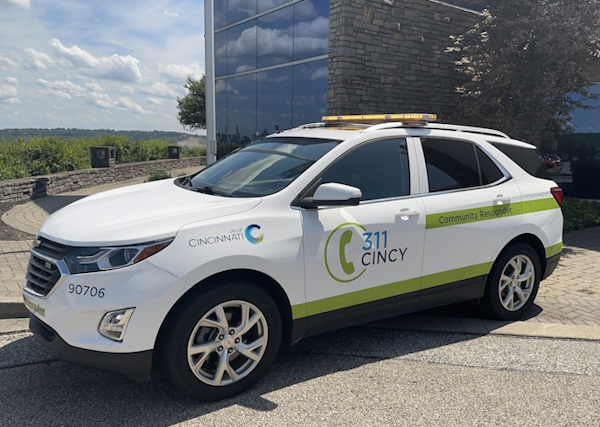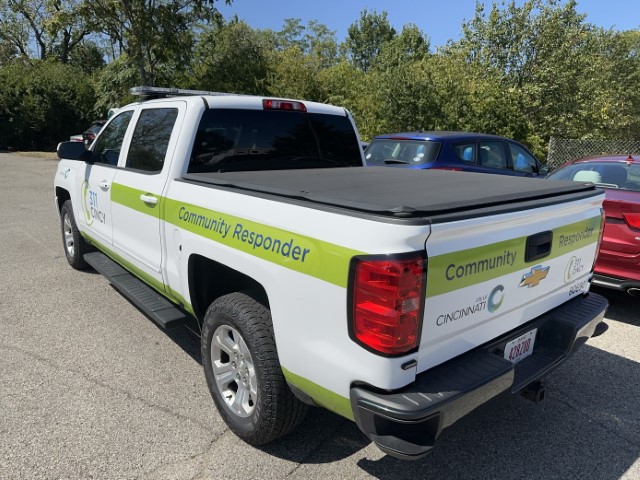Community Responder FAQ
 The City's Alternative Response Program, managed by the Emergency Communications Center, works to enhance public safety through community-centered approaches to intervention as alternatives to traditional responses and the criminal justice system.
The City's Alternative Response Program, managed by the Emergency Communications Center, works to enhance public safety through community-centered approaches to intervention as alternatives to traditional responses and the criminal justice system.
One initiative of this program is our Community Responders, a new team initiated by the City Manager in 2024.
Frequently Asked Questions
A Community Responder is a City of Cincinnati employee working within the Alternative Response Program. This program is managed by the Emergency Communications Center (ECC), an agency of the City Manager's Office.
While the role and staff are referred to publicly as Community Responder, their internal job title is Alternative Response Community Service Officer. To read the official job description, click here.
The program began in 2024 with 2 Community Responders and has grown to 14 staff members as of December 2025. These responders work in teams of 2 providing a field response for 311 and nonemergency city services.
This employee provides field response in the community for the City's non-emergency 311 Customer Service program and serves as an ambassador to the community on behalf of all City of Cincinnati agencies. This employee plays a crucial role in improving community outcomes by handling issues that do not require a traditional public safety response.
The Community Responder initiative is an expansion of the same model used to establish the City's Alternative Response to Crisis (ARC) teams. While ARC will continue to handle low-level crisis situations in lieu of police, connecting those in crisis with resources, Community Responders perform a similar function with non-crisis, non-emergency calls for service. Community Responders also spend scheduled time maintaining a presence in some public spaces, such as transit centers, to build connection with community and identify needs for services.
While Community Responders may respond to and assist someone in lieu of a Police Officer, they do not perform the duties of a police officer. Community Responders, for example, do not investigate crime, investigate traffic crashes, or enforce laws. When a situation requires law enforcement (e.g., someone needs to report a theft), Community Responders would call for police or provide direction on how to obtain those services.
Many calls, such as assisting a motorist with a disabled vehicle while they wait for a tow truck, take up a significant amount of police time. Each year, the Cincinnati Police Department handles thousands of calls for disabled vehicles and minor, non-injury crashes. Police officers are routinely used as the "eyes and ears of the city," sent to make an initial assessment of a report to 311 about traffic hazards, signal malfunctions, or possible water main breaks. Sending a Community Responder in these circumstances frees up police to handle urgent law enforcement matters.
However, Community Responders do not investigate crime, investigate traffic crashes, or enforce laws. Those functions are performed by a Police Officer. For example, if a Community Responder assists someone involved in a minor traffic crash, the Community Responder will take steps to keep people safe while they await a tow truck, and provide information (e.g., how to obtain a crash report at a police station). They will not investigate or produce a report regarding the crash.
Beginning in 2025, Community Responders will be on-duty between 7am and 7pm Monday-Friday. Community responders operate in all City neighborhoods. They encounter diverse environments, from residential streets to public spaces. Community responders drive City vehicles and work outdoors, so they face different weather conditions—including rain, snow, heat, or cold. Responding to requests for service can take them to homes, parks, schools, shelters, or other community hubs; this also includes work in the roadway when assisting motorists. Community Responders also spend scheduled time maintaining a presence in some public spaces, such as transit centers, to build connection with community and identify needs for services.
Community Responders are dispatched by the Cincinnati Emergency Communications Center (ECC).
ECC call-takers evaluate calls received using a protocol system. The system directs appropriate incidents to alternative responders, such as Community Responders, based on the specifics of each incident, and associated safety considerations.
When an eligible incident is routed to an ECC police dispatcher, the dispatcher will evaluate whether there is a traditional response unit available. If not, the dispatcher will get approval from a supervisor prior to dispatching a Community Responder Unit. If there is not one on duty or they would not be able to respond in a reasonable period of time, the traditional response will be dispatched instead.
Community Responders are connected to ECC dispatchers in the same way as the City's other public safety responders, with radio and data communication tools.
The City has intentionally made Community Responders, and their vehicles, easy to identify. It is also the intention to make it clear that Community Responders are not other types of responders, such as police officers or firefighters. Community Responders wear uniforms and identification that represent them as City of Cincinnati employees.
Their vehicles are distinctively marked with green striping, "Community Responder" text, and amber warning lights. In addition to the reflectivity necessary for traffic safety, the green striping and unique graphical design is meant to contrast the blue and red of traditional public safety vehicles. The same is true for the amber color of the vehicle's warning lights.


No. Community Responders are not a replacement for Emergency Medical Services (EMS). If Cincinnati 911 receives a report of a medical emergency, those incidents will continue to receive a traditional EMS response.
They are connected to the 911 center by radio and can quickly request help. If a medical emergency is encountered by a Community Responder, they will request an EMS response from the Cincinnati Fire Department.
Community Responders are CPR/AED certified and trained to administer naloxone (Narcan). While EMS is on the way, they may provide immediate life-saving interventions, such as CPR, defibrillation with an AED, or resuscitation of an overdose victim using naloxone - the same interventions performed by any trained bystander.
No, Community Responders do not perform investigations or enforce laws, which are duties of a Police Officer.
For example, if a Community Responder assists someone involved in a minor traffic crash, the Community Responder will take steps to keep people safe while they await a tow truck, and provide information (e.g., how to obtain a crash report at a police station). They will not investigate or produce a report regarding the crash.
Based on the job description, each applicant must have a High School diploma or equivalent GED and two years of experience working in social service, crisis intervention, community advocacy, peer support groups or related fields.
Once hired, Community Responders receive training applicable to their role. To serve as an ambassador to the community on behalf of all City of Cincinnati agencies, Community Responders must become knowledgeable about service delivery processes throughout the city. They also gain various certifications in topics such as first aid, mental health condition awareness, de-escalation, and mediation.
Community Responders receive classroom training for three weeks, which includes: 311 and city service delivery training, Defensive Driving training, bloodborne pathogen training, CPR and First Aid training, CJIS security and privacy training, Crisis Intervention Training, radio and MDC communication training, situational awareness safety training, and Traffic Incident Management training. Additionally, they receive at least three weeks of field training, gaining hands-on experience in the role prior to being released for independent work. In general, the knowledge of a Community Responder includes:
- Local neighborhoods, cultural nuances, and community resources.
- Common mental health conditions, crisis intervention techniques, and available support services.
- De-escalation strategies, active listening, and mediation techniques
- Social Services: Awareness of available social programs, housing assistance, and substance abuse treatment options.
- City Services: Awareness of City agencies, services, processes, and programs.
- Principles and best practices of excellent customer service.
- Departmental policies and procedures. Safety policies, procedures, and principles.
